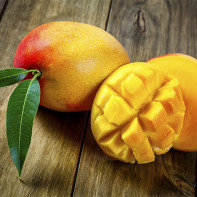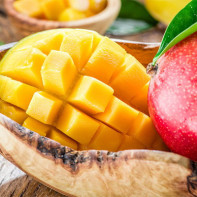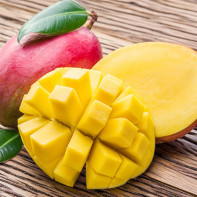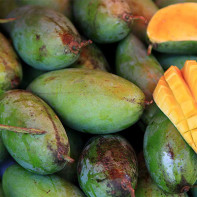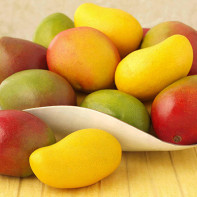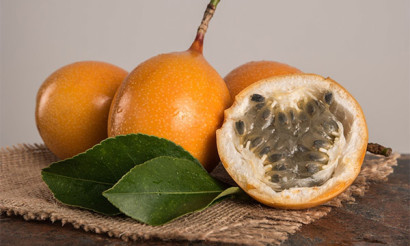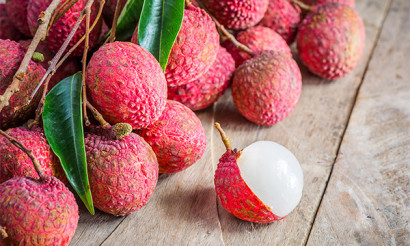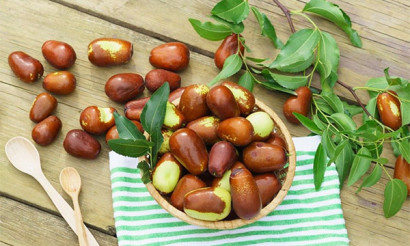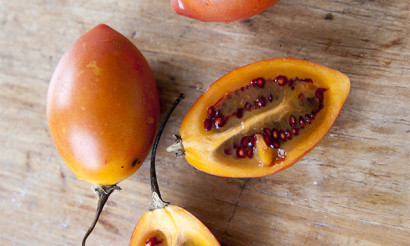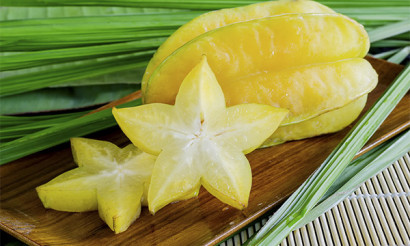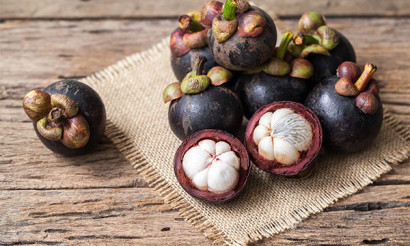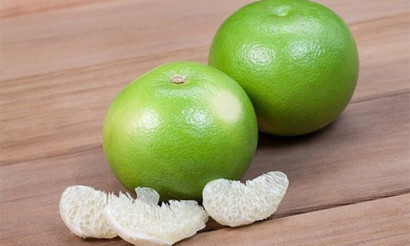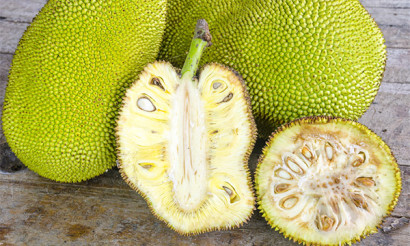Mango (fruit): useful properties and contraindications.
In our latitudes, the mango is considered an exotic fruit, but it has become widespread in Southeast Asia. The mango fruit is sold in local shops, markets in stores, and even in cars right on the street. It is important to note that the fruit of the exotic fruit is not available all year, but only during the ripening period. The mango is sometimes called the "great fruit" because that is the translation of the word "mango" itself.
- What is a mango and where does it grow
- Types
- Composition and calories
- What are the benefits of mangoes?
- General benefits
- For Women
- For Men
- Pregnancy
- For breastfeeding
- For Children
- Dried Mangoes: Benefits and Harms
- Benefits of Mango Juice
- Mango Butter: Properties and Application
- Can I Eat Mango to Lose Weight?
- Mango in Medicine
- Diabetes
- In Pancreatitis
- For Gastritis
- For Intestines
- For constipation
- For gout
- For the liver
- For hemorrhoids
- For cholecystitis
- Mango in cosmetology
- For Face
- For hair
- For the Body
- Harm and Contraindications
- Mango allergy symptoms
- How to Choose a Ripe Mango from a Store
- How to speed up the ripening of mangoes
- How to Store Mangoes at Home
- Can I Store in the Fridge
- What to Eat Mangoes Right
- How much can I Eat in a Day?
- Can I Eat Mangoes at Night and on an empty stomach?
- Can I Eat Mango Peels?
- Whether or not a mango pit is edible.
- How to peel a mango properly
- What can be made out of mangoes: Recipes
- Jam
- Smoothie
- Juice
- Puree
- Candied
- Can I Give Pets Mangoes
- How to grow mangoes from a stone at home
- Interesting Facts about Mangoes
What is a mango tree and where it grows
The fruit of the mango tree can have different colors - green, yellow, orange and red. The fruit is slightly elongated and egg-shaped in shape. The weight of a single fruit may range from 200-250 grams. Sometimes there are larger fruits weighing up to half a kilogram and even real record-breakers weighing up to one and a half kilograms. Mango rind has a dense and smooth structure. The flesh is fibrous, the taste is sweet. The pit, located inside, has a light yellow hue and a slightly flattened shape.
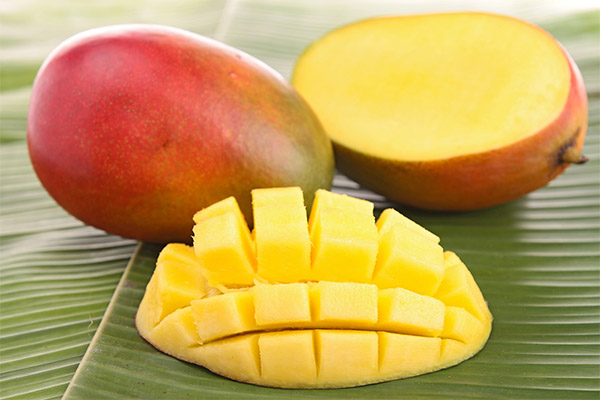
To experience the true flavor of the mango fruit, you need to eat the just ripened fruit from the tree. Store-bought fruit tastes slightly different because it is picked when it is still green. Mango fruits have a characteristic flavor - some combination of pineapple and peach. The fruit has quite delicate flesh. It helps to quench thirst on a hot day and fills the body with freshness. Mangoes are very common and popular in Thailand. The climatic conditions of this country are perfect for growing this tropical fruit. It is worth noting that the mango season is not very long, but rather even short, because it lasts only about 1 month (April-May).
The mango tree is an evergreen plant. It can reach a height of up to 40 meters. Nowadays, there are dwarf species that are more suitable for cultivation and are specifically designed for industrial scales. Young leaves have a reddish hue, which gradually turn green as they mature. During flowering, small yellowish flowers grow on the crown.
There are different varieties of mango, differing in color and size of the fruit itself. Some varieties are self-pollinated. Sometimes trees refuse to bear fruit due to insufficiently comfortable climatic conditions. Mango feels well in southern latitudes, where night temperature does not fall below 13 degrees Celsius. The tree does not like the strong humidity, for normal development he needs constant access to fresh air and sunlight. Therefore, the mango tree should be grown in an open area.
Types
There are many different varieties of mango (about 200), but not all are widespread. The most popular are considered a few dozen varieties, which have excellent taste and many health benefits. Here are some of them:
- Alfonso. The fruit of this variety is quite expensive. The place of cultivation is India. The fruit has a creamy flesh texture. The consistency of the fruit is dense and relatively hard, while the flesh has a feature to melt in the mouth. It has a sweetish taste and a light saffron aroma. Weight of fruit ranges from 150-300 grams. Harvesting takes place between the end of March and May.
- Cesar. Originating in Gujarat, India. Harvested in June-July. The fruit is very popular because it has an interesting flavor-a combination of acidity and sweetness-and a rich, pleasant aroma. Despite the slightly unsightly appearance of the fruits - rounded shape, small size and yellowish spots - they have a great bright yellow flesh and smooth texture that compensates for these shortcomings.
- Banganapalli. The place of cultivation is Chennai, India. Fruits have an elongated shape, sweet flesh without fibers. The skin of the fruit has a golden yellow color, it is not very strong. The fruits are quite large, weighing up to 400 g.
- Dashery. The place of cultivation is Northern India. According to legend, the history of this variety began when one of the traders, quarreling with a sage, threw the fruit on the floor. Its pit fell into the soil, and from it grew a tree. Today the tree is about 200 years old and still produces a crop every season. The fruit has a sweetish flesh and has a delightful aroma.
- Kent. It is native to southern Florida and Miami. The fruits are of excellent quality, they are transportable and resistant to various diseases, so they are very popular around the world. The flesh of the fruit has an exquisite texture and is highly palatable, with virtually no fibers. The fruits are green in color and have a beautiful red blush. It is high yielding and has a long fruiting period. Harvesting is June-September.
- Sindri. Is grown in Sindh province of Pakistan. Harvested between June and July. The fruit of this variety has an exceptionally sweet taste, which is why it is sometimes called a honey mango. The fruit is elongated and slightly crooked in shape. The color of the skin is uniform and there are no blotches or spots. The flesh has a soft structure, so the fruit can not be stored for a long time. Usually recommend them for the first 2 days after purchase.
- Mahachanok. The place of cultivation is Thailand. The fruits of this variety are quite widespread in the CIS under the label "exotic fruit". Ripe mangoes have a characteristic taste of this fruit. The fruits are oblong in shape and vary in weight from 250 to 350 g.
- Langra. Occurs in northern India. Its fruiting season is fairly short, occurring from mid- to late July. Fruits have a wonderful taste and delicate flesh which melts quickly in the mouth.
- Chausa. Occurs in Pakistan and northern India. Fruiting season is from June to August. Fruits have a sweet taste and a peculiar pleasant aroma. The flesh is soft, pleasant to the taste, without fibers.
- Neelam. Growth area - India, Pakistan. A very high-yielding variety. Harvesting - May-June. Fruits are fairly small, have tiny seeds and a pronounced aroma.
- Gulab Has. Fruits have a reddish flesh and a wonderful aroma. The color of the skin is light yellow. The fruit is excellent for making a variety of fruit desserts.
Composition and calories
In 100 grams of product contains:
- Calories - 60 kcal.
- Protein - 0.8 g.
- Fats - 0,4 gr.
- Carbohydrates - 13,4 g.
In addition, the product contains vitamins A, C, D, B (B1, B2, B5, B6, B9), as well as beta-carotene. Mango is also rich in potassium and zinc, calcium and manganese, as well as phosphorus and iron. The fruit contains fiber, pectin, mangosteen, organic acids and sucrose.
What are the benefits of mangoes?
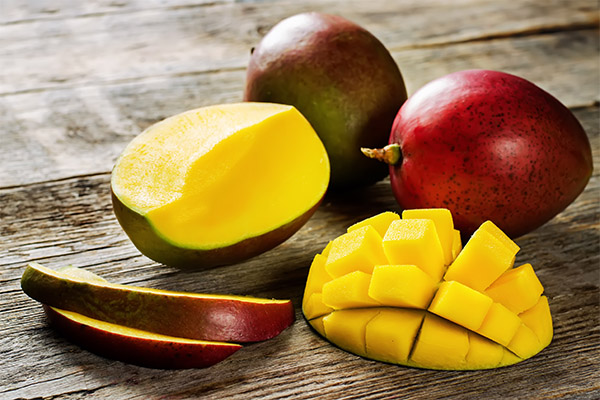
General benefits
- Cancer prevention. Mangoes contain many antioxidants that help reduce the risk of cancer. These substances are especially effective in fighting colon and breast cancer. Separately, beta-carotene is an antioxidant that will not only protect the body from breast and colon cancer, but will also prevent leukemia.
- Skin benefits. Mango contains collagen, a substance responsible for the firmness and youthfulness of the skin. To maintain the health of the skin mango can be used as a food and as a base for making various nourishing masks.
- Stimulation of sexual function. Vitamin E contained in the mango fruit has an effect on a person's sex drive. The better the balance of vitamin E in the body, the greater the sex drive. Studies have shown that beta-carotene along with vitamin E improve the quality of sperm.
- Supports brain health. B6, a vitamin present in mangoes, is involved in the production of neurotransmitters and thus supports brain function. When vitamin B6 is deficient, a person's cognitive abilities are significantly impaired. Vitamin B6 is also useful in treating asthma and takes away unpleasant symptoms of premenstrual syndrome.
- Alkalizing effect. To maintain adequate alkaline levels in the body, you should consume mangoes regularly, but it is important to remain in moderation. The potassium found in mangoes is a substance that helps to alkalize the body. Regular alkalizing helps reduce the risk of chronic diseases.
- Eye Health Benefits. If the body is deficient in vitamin A, it can lead to decreased vision quality or complete blindness. Vitamin A plays an important role in maintaining healthy eyes and vision. Mango is rich in vitamin A, so this fruit helps keep your eyes healthy.
- Hypertension check. Hypertension can cause cardiovascular disease, and the mango is a fruit that is rich in potassium. Potassium helps support heart health and prevents hypertension.
- Support for bone health. The vitamin A and C content in mangoes makes this fruit a great food for bone health. Collagen and vitamin A are substances that play an important role in maintaining bone health. However, it is very important to consume in moderation, as excessive amounts of these vitamins can even be detrimental.
- Benefits for the digestive system. Mango supports the digestive system and helps it function smoothly. The terpenes and esters found in mangoes help lower stomach acidity. The high fiber content can also help people avoid GI disorders.
For women
Ripe mango fruits are rich in useful micro- and macronutrients, such as iron, which significantly helps to reduce the risks associated with the development of anemia during menstruation or pregnancy. Mangoes also normalize the digestive process, especially when combined with milk. In addition, the fruit has a laxative and diuretic properties, which, given the low caloric content of the product make it indispensable in the period of weight loss.
Also the fruit is highly recommended to eat in case of high cholesterol. Mango helps to cleanse the skin, makes it firmer and gives it a healthy color, so the fruit can be used in various face and hair masks. On top of everything else, they can also increase libido.
For men
For a long time, the mango tree has had another name, and that is the "fruit of love". This fruit got this name because it contains substances that can affect the functioning of the male reproductive system. The fruit contains vital elements that are necessary for the body to maintain the health of the male reproductive system, namely zinc, selenium, copper, manganese, potassium and others. In addition, mangoes contain a large amount of vitamin E, which is able to increase libido and improve potency. In the case of regular consumption of mangoes reduces the risk of diseases of the male genital system.
When pregnant
Mango contains a lot of vitamins, so this fruit is very useful during pregnancy. The fruit is rich in folic acid, which is involved in the processes of formation of the nervous system of the child, so the fruit can even be prescribed to pregnant women as a food product. Vitamin A is also important in pregnancy because it can support the normal development of the placenta.
It is also worth noting that fruits contain phenols in fairly large quantities, which inhibit the harmful effects of free radicals. An important point is also the maintenance of digestive processes, especially during pregnancy, because it is during this period that disturbances occur due to not quite standard conditions of the body. Fiber and natural enzymes contained in mangoes stabilize the gastrointestinal function, and iron will help avoid hypoxia in the fetus. Potassium helps to stabilize the water balance and reduces swelling.
A pregnant woman will have enough of 1 fruit (medium size) per day to prevent the most common disorders that can occur during this period. The changes that pregnancy brings with it often negatively affect the appearance of the skin. To avoid unwanted effects, you can use mangoes as a skin care product.
Despite the positive effects, mangoes can also be detrimental to pregnant women. It is not quite a familiar fruit for many people, so include it in your diet with caution, especially pregnant women. This product can in some cases cause allergic reactions, so you should start with small portions with further monitoring of your condition. If after drinking there was diarrhea or rashes on the skin and abdominal pain, then from the mango should be abandoned, so as not to harm the baby. Excessive consumption of fruit is also forbidden, because mango is rich in vitamin A, which in large quantities will have a negative impact on the body of a pregnant woman. It's also worth knowing that mango peels contain a toxic resin that should not be consumed.
When you are breastfeeding.
Mango is allowed to consume during lactation, because it contains many useful substances that the mother needs in the postpartum period to restore the body. But despite the benefits of the mango fruit, we cannot say affirmatively that this product can not harm the health in cases of violation of the rules of consumption, especially when it comes to a breastfeeding mother. Some substances contained in mangoes may simply not be absorbed by the baby's body due to its age. In addition, both the mother and the child may have allergic reactions to the exotic fruit.
For children
It is generally believed that a child can be given mangoes at 7-9 months. But it should be noted that this applies only to those countries in which mango is a non-exotic product. People who are not used to eating such fruits on a regular or periodic basis, the consumption rate should be reduced, especially if we are talking about children. Here are some rules on the consumption of mangoes:
- At the first intake, you can give up to half a teaspoon of the fruit, mashed into a puree.
- Also, you should not mix mangoes with other fruits in the same serving at the first reception.
- It is recommended to take the dish before dinner, so that after consumption there is time to monitor the child's reaction.
In the case of allergy symptoms, it is necessary to contact the doctor (pediatrician or allergist) and consult about it, and it is forbidden to self-medicate.
Another important point, which sometimes parents do not pay attention to, is the fact that the fruit must be removed from the skin. The substances it contains can cause mucosal irritation. In addition, in cases of allergy to pistachios or pine nuts, it is not allowed to use mango.
Dried mango: benefits and harms
Mango in dried form - it is not just tasty. This product has a number of useful properties. As well as fresh fruit, dried fruits normalize the work of the gastrointestinal tract, improve metabolism. They contain fiber, which helps to eliminate toxins from the body. Dried mango is good for the heart muscle.
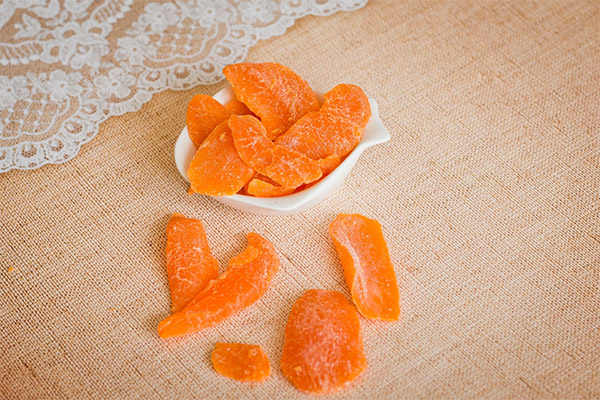
But the dried fruit can also be harmful to the body. For some people, this exotic product can be hard to digest, so you need to be especially careful when taking it for the first time. The acids contained in the dried product sometimes cause allergic reactions, so it is important to observe moderation.
The benefits of mango juice
The useful properties of mango juice:
- Helps slow the aging of the eyes and prevents blindness;
- prevents respiratory diseases;
- Relieves inflammation and treats viral lesions;
- cleanses blood vessels;
- maintains normal blood pressure.
Mango butter: properties and uses
The oil has many beneficial properties that can cure dermatitis and psoriasis. It also effectively helps to get rid of muscle pain, relieves tension and fatigue. Mango butter maintains normal moisture levels in the skin, so it can be used after a visit to the bath. In addition, the oil helps to eliminate the effects of drying out, for example, burns or chilblains.
The main purpose of the oil is the regular care of the skin, hair and nails.
Is it possible to eat mango when losing weight?
In addition to the fact that the fruit has an obvious beneficial effect on health, it can also be an excellent assistant in the fight against excess weight. When you eat mango, the body begins to actively produce the hormone leptin, which is involved in the processes associated with the accumulation of fat, and can regulate them. Also with the addition of mango fruit in the diet increases the efficiency of the breakdown of fats and begins to eliminate them from the body.
B vitamins in the fruit are a stimulant for the liver and help in the burning and excretion of carbohydrates deposited as fat. The process of elimination of fat from the body is activated, there is a conversion of fat into energy, resulting in more calories burned. In this case, the substances contained in the fruit suppress appetite, which allows you to do without additional and not the most useful snacks. Among other things, it is worth noting that mangoes have significantly more potassium than bananas. It helps to avoid fluid retention in the body. Pectin and vegetable fiber help to improve digestion and metabolism, which is also very important in the period of weight loss. The main advantage of mango is that it has very few calories (only 60 kcal per 100 grams).
Mango in medicine
Mango is also widely used in medicine. For example, in some European countries it is recommended to chew mango pieces for 14 days - it helps to strengthen the heart muscle. Mango leaves are used to make various decoctions that improve vision, they are especially useful for people suffering from diabetes. In case of varicose veins, multiple hemorrhages on the skin, a course of decoctions based on mango leaves should be taken.
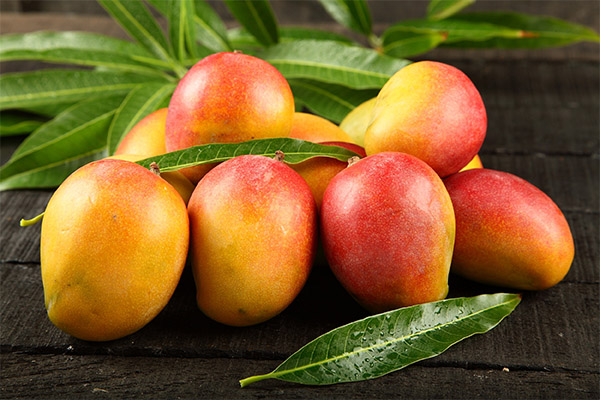
In Asia, these fruits are treated for plague and cholera. The fruit is also diuretic and laxative, and can be used to improve blood clotting in cases of internal bleeding.
Mango juices can help treat acute dermatitis, and the seeds can be used to treat asthma. Mango helps digest meat dishes and prevents heartburn.
In Diabetes Mellitus
When you have diabetes, it is recommended to follow a diet that may include mango. The useful properties of this fruit can be used for the prevention of diabetes, as well as a means of treating it. There have been numerous studies that have shown that mango helps to prevent the loss of intestinal bacteria, a sufficient number of which reduces the risk of gaining extra pounds, as well as reducing the likelihood of type 2 diabetes.
The fruit helps normalize blood sugar levels, which is very important for diabetes. Mango fruits have a low glycemic load (55), but it is still necessary to observe moderation in the consumption of this product. It is not recommended to eat more than 1-2 slices of mango at a time.
In pancreatitis.
During an exacerbation of the disease, exotic products should be excluded from your diet or reduce their consumption to minimal portions. Ripe delicious fruit can cause severe allergies and allergic pancreatitis. In this case, the allergens can be both the nutrients contained in the fruit and the preservatives with which the fruit was processed. Slightly loosen the ban and start slowly eating mangoes only in the period of stable remission. Mango will not only bring pleasure to lovers of sweets, but also have a positive effect on the overall functioning of the body.
Gastritis
During acute conditions it is definitely not allowed to eat mango. This fruit does not meet the established requirements of a special diet. In this case, and in the period of remission, it is necessary to establish a restriction on the consumption of the fruit. When the condition normalizes, it is necessary to consult with a specialist about the further diet and the presence of mango fruit in it, because it depends on individual characteristics. In almost all cases, this fruit is allowed to be consumed, but again, in limited quantities. In case of abuse, there may be problems with the gastrointestinal tract, which will aggravate the situation.
For the intestines.
Mango can act as a digestive regulator and have a mild laxative effect. Even dried fruits help regulate the processes of cleansing the intestines, because they contain enzymes that promote the removal of toxins. In addition, fruits contain concentrated fiber, which supports the health of the gastrointestinal tract.
For constipation
The fiber and polyphenols in mangoes make them great natural remedies for constipation. The dietary fiber helps ease digestion and helps eliminate toxins from the body. Thanks to the polyphenols, mango helps to reduce inflammation and suppress the processes associated with this condition. During their digestion there is an acceleration of the excretion of toxins, improves the composition of the intestinal microflora.
In gout
When suffering from gout, it is necessary to follow a strict diet, which should not include products that contain oxalic acid. This acid is contained in mango, so it is not recommended to eat it both during the remission of the disease, as well as during an exacerbation.
For the liver
Mango has beneficial effects not only on the gastrointestinal tract, but also on the liver. It contains quite a lot of minerals and fluid, which contributes to the effective cleansing and normalization of the organ.
In hemorrhoids.
Mango is highly recommended in the case of hemorrhoids, because it helps to improve intestinal peristalsis. As a rule, in this case, it is advised to consume unripe fruit with honey and salt. This will help to facilitate the elimination of feces from the body, reduce the irritation of the inflamed area.
In cholecystitis
With cholecystitis, it is very important to follow a diet in which there should not be any acidic berries and fruits. For this reason, it is recommended to exclude mango from your diet.
Mango in cosmetology
In the field of cosmetology, mango oils or mango extract are used. The oil is used as a skin care product because it helps to regenerate the skin, nourishes it with nutrients and has a moisturizing effect. It is most effective for damaged or dry skin. The oil can be used for children and sensitive skin, as it has a regenerating effect and stimulates the healing of wounds.
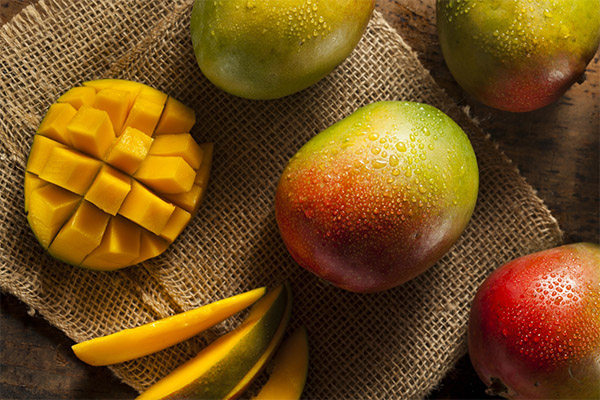
In addition, mango oil helps to restore the lipid barrier, maintains the ability to retain moisture in the body, prevents chilblains, frostbite, gets rid of allergic skin manifestations. It has a soothing effect on rough skin, prevents stretch marks, improves elasticity. Also, mango butter has a beneficial effect on the hair, strengthens the roots. Mango extract contains a variety of vitamins that enhance the regeneration of the body and stimulates cells to renew.
Mango also helps to remove dead skin, giving it a more youthful and fresh appearance. Mango extract nourishes the skin, saturates it with nutrients, helps to moisturize and neutralize the effects of free radicals that stimulate premature aging.
For Face
Oily skin mask
- Remove the skin from a mango and remove the flesh from the pit.
- Grind into a jelly-like consistency.
- Wash your face with cool water (you may use a gel or foam).
- The resulting mixture applied to the face, without affecting the eye area.
- Wait for 10-15 minutes. Wash your face with cool water.
Nourishing mask
- Mango peel and grind.
- Add mango (2 tbsp.), bee honey (1 tsp.) and olive (or peach) oil (1 tbsp.).
- The resulting mixture applied to the face. Wait for 20 minutes. Wash your face with water.
For hair
Nourishing hair mask
- Peel washed mango (1 piece) from the skin and mash it to a mushy consistency.
- Mix the mush with honey (1 tbsp.) and stir.
- Thoroughly rub the mixture into the hair and wrap the head in foil.
- Hold for 30 minutes. Rinse the mask with warm water and shampoo your head.
Moisturizing hair mask
- Crush the mango (1 piece) to a paste.
- Add 2 egg yolks and a little natural yoghurt to the mixture.
- Mix the mixture until homogeneous.
- Massage movements, rub the resulting mixture into the hair, wrap your head with a towel.
- Leave on for 60 minutes. Wash the mask with water and rinse your head with shampoo.
For Body
Moisturizing body mask
- Warm the almond oil (3 tbsp) in a steam bath.
- Pour the oil into a container, add 200 ml of cold sourdough starter and stir together.
- Crush the mango, add the mush (3 tablespoons) to the oil and sourdough and mix.
- Rinse your body in a shower and apply the mixture to the body.
- Hold for 20 minutes. Rinse off with cool water. Apply nourishing body cream.
Harms and contraindications
- You should not consume more than 1 green mango fruit per day, because the fruit can have an irritating effect on the throat or cause upset stomach.
- When consuming mangoes, it is necessary to observe moderation in the period of weight loss, because the fruit contains a lot of sugar.
- If you are overweight, have high blood pressure, diabetes or high cholesterol, you also need to control the amount of fructose that goes into your body with the mango.
- It is not recommended to drink cool water immediately after consuming the fruit, as this increases the risk of irritation of the intestinal mucosa.
- In gastritis with hyperacidity and stomach ulcers, mangoes can be eaten only in minimal quantities.
Symptoms of mango allergies
Allergic reactions to mangoes are quite rare. Typically, allergies result from contact with the skin of the fruit. Here are some of the symptoms of allergies:
- Contact dermatitis. Skin inflammation can occur around the mouth due to body contact with the fruit. Symptoms may include redness, itching, and exfoliation of the skin. To get rid of the inflammation, you should thoroughly wash the site of irritation, lubricate with an ointment designed to treat allergies, and then try to avoid contact with the fruit in question.
- Quincke's oedema. The allergy can also manifest itself as Quincke's edema. In this case, after contact with mangoes, swelling of the face and lips occur. Subcutaneous swelling - angiodystrophy - may also appear.
- Anaphylaxis. Sometimes allergic reactions can provoke anaphylaxis, decreased blood pressure. In addition, breathing can become difficult, and this condition is life-threatening. Symptoms may also appear as diarrhea, cramps, abdominal pain, trouble swallowing, itchy skin of the eyelids and face. Anaphylactic shock is a dangerous condition that can lead to death if left untreated.
How to choose a ripe mango in the store
When buying mangoes, you should pay attention to the skin and the smell of the fruit:
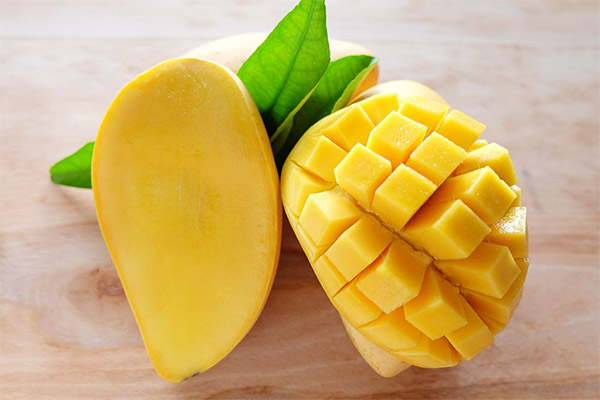
- You need to press lightly with your finger on the skin, with a small trace left from the pressure. If the fruit is too soft, or the skin is not able to withstand the pressure, it is likely that the product has already gone bad.
- You should also avoid buying the fruit if the skin is wrinkled or flabby.
- If the fruit is too hard, it indicates that it is immature.
- Try to catch the smell of the fruit. Ripe mangoes have a sweet aroma. Near the stalk of the fruit, the smell is richer, with a bit of resin and pine. The absence of an odor indicates that the fruit is immature. An overpowering, sourish smell suggests it is overripe.
- Mangoes may vary slightly in shape. The main thing is that the fruit should not be deformed.
How to speed up the ripening of mangoes
There are several methods that can help speed up the ripening of mangoes without much effort in a short period of time. Here are some of them.
- Using paper. To allow the fruit to ripen properly, you should wrap it in paper or newspaper and leave it at room temperature. It is important not to wrap the fruit too tightly, otherwise mold may form. During 1-2 days the fruit will visibly soften, a fruity flavor will appear.
- With grits. Place the fruit in a bag (paper), a pot or any other container filled with corn seeds or rice. You can use basically any grits. Mangoes can ripen in as little as 24 hours or even a few hours.
To prevent the fruit from overripening, its ripeness should be checked every 2-5 hours.
How to store mangoes at home
Depending on the condition of the fruit, there are different ways to store it:
- Fresh ripe fruit can be stored in the kitchen for up to five days. Note, however, that mangoes should be kept in a cool place with a temperature of around 10°C.
- Unripe mangoes can be stored for about seven weeks. The temperature should be 8°C and the humidity should be about 90%. To speed up the ripening process, wrap the fruit in paper and put it in a place away from sunlight.
Can I keep them in the fridge
Mangoes can also be frozen. This allows the product to be kept for 10 months in the refrigerator. It is advisable to slice or grate the mangoes and put them in the freezer.
The best way to eat mangoes
Mangoes are usually consumed peeled because the skins are inedible. The fruit can be cut into slices, slices, or chunks. Mangoes are considered more delicious when refrigerated.
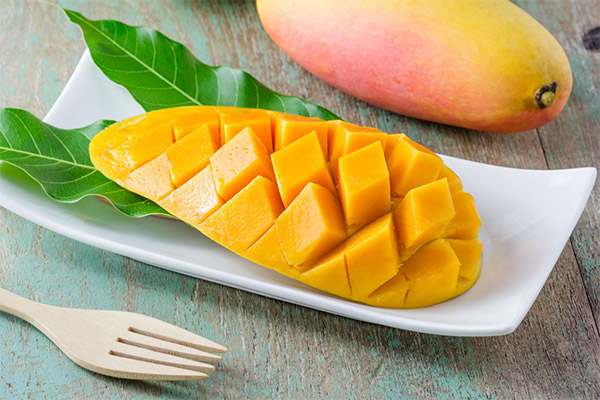
How much you can eat per day
The daily rate of consumption is considered no more than 1-2 fruits.
Can I eat at night and on an empty stomach
Mango can be eaten at night, but it is recommended to eat the fruit 3 hours before going to bed. The benefit of eating on an empty stomach is not quite obvious, because irritation of the mucous membranes of the digestive organs can occur.
Can I Eat Mango Peels
The peel of the mango fruit is inedible. It contains toxic resins that can harm the body. Therefore, you should peel the fruit before eating it.
Is the mango seed edible?
If we talk about the mango pit, it's worth noting that it has no flavor, and therefore it makes no sense to eat it. As a rule, the pit is just thrown away or planted for further mango cultivation.
How to peel a mango tree
Here are a few ways to peel the mango fruit:
- Using a regular knife, like a potato.
- With a potato peeler (a triangular one is recommended).
- Make a cross-shaped incision in the fruit on top and pull the edge, cut the skin into 3-4 pieces along the fruit and remove the resulting petals.
What to make with mangoes: Recipes
Mango fruits can be eaten fresh, they can be used to decorate desserts, eat together with yogurt, porridges and fruit salads. The fruit can also be dried, pickled and dried. Mangoes are used as a garnish to meat dishes and spicy seasonings are made from the fruit. The fruit can be used in curries.
Jam
Ingredients:
- Mango pulp - 150 g;
- sugar - 150 gr;
- water - 20-30 ml.
How to cook
Cut the mango into small pieces. Add water and sugar. Cook over low heat for 20 minutes. Leave it to cool.
Smoothie
Ingredients:
- banana - 1 pc;
- mango - 1 pc;
- orange juice (freshly squeezed) - 500 ml;
- yogurt (natural) - 4 tbsp.
How to prepare:
- Cut the mango in half and remove the pit, then cut the fruit into strips and place in a blender.
- Add the peeled and cut banana together with the juice to the mango.
- Mix all the ingredients in a blender until a smooth consistency.
- Pour into glasses.
Juice
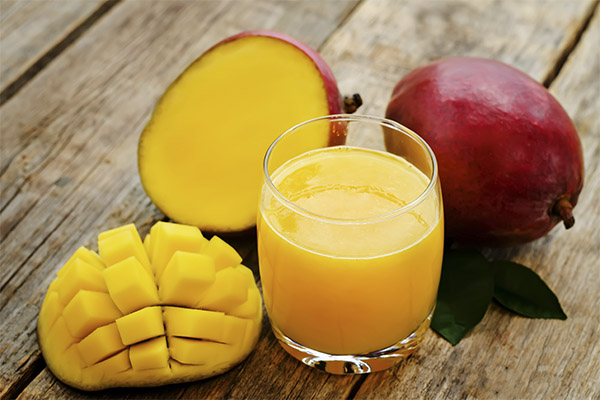
Ingredients:
- mango - 2 pcs;
- water - 1 tbsp;
- sugar - 2 tbsp.
How to cook
Peel the mango. Cut it into small pieces. In a blender, put mango, crushed ice, water and sugar. Blend until smooth. Squeeze the resulting mass through a sieve. You can discard the pulp. Serve the juice in glasses.
Puree
Ingredients:
- mango - 3 pcs;
- butter - 50 gr;
- pine oil.
How to prepare:
- Remove the peel and pit from the fruit.
- Grind the mangoes with a food processor to a purée, then put them in a saucepan.
- Add oil to the pot and put it on a low heat for 15-20 minutes.
- After that, grind again in the food processor.
- Add a few drops of pine oil.
- Place in refrigerator to cool.
Candied
- Rinse the mangoes, remove the stalks, seeds and skin, then cut into halves.
- Dry the fruit to remove the moisture.
- Prepare syrup - water (1 l) + sugar (900 g).
- While the syrup is boiling, add diced mangoes.
- Boil the fruit for 10 minutes. Then put them in a colander to drain the syrup.
- Place the fruit in a single layer on a baking tray and dry in the oven (at +40°C).
- Take the dried fruit out of the oven and sprinkle it with powdered sugar.
Can animals eat mangoes?
Dogs are allowed to eat mangoes, but in moderation and occasionally. If we talk about cats, they are contraindicated to exotic fruits, including mangoes. If a pet likes mango fruit on its own, you should monitor its well-being. In the future, it is better to protect him from such unnatural food for him.
How to grow mango from a stone at home
For planting is suitable just extracted from the fruit of the pit. It should be well washed and scraped off the remaining pulp. The pit should be split, this will contribute to the better growth of sprouts.
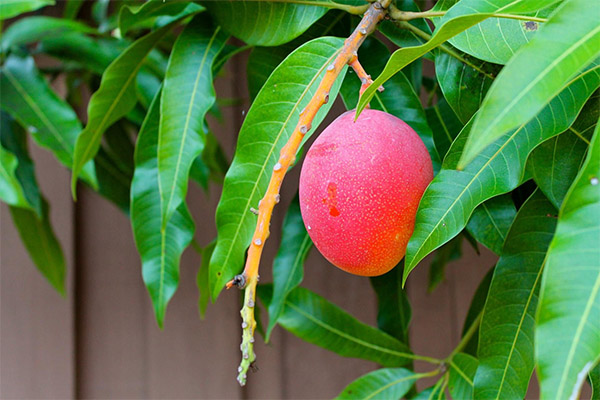
Then you need to prepare a pot. It is recommended to choose a large and capacious. In it it is necessary to lay drainage - pour a little fine crushed stone, this will prevent stagnant water. For planting, the soil of the universal type will be suitable.
Plant the seed can be planted sideways or horizontally (in the presence of a small sprout). Completely fill the pit with soil is not allowed, it is better to make sure that a quarter of it remains on the surface. After that, you need to water everything well with water. When settling the soil, you need to add another layer of soil.
It is recommended to cover the pot with a thin glass plate or cellophane cover. Every 2-3 days, lift the edges of the cover to ventilate the seedling. The pot should be placed in a place with constant access to sunlight.
Interesting Facts about Mangoes
- The mango tree is native to Myanmar and the Indian state of Assam. In this area, mango has been grown for 4 thousand years.
- The main supplier is India.
- There are more than 200 varieties of mango.
- The mango tree can reach a height of 50 meters.
- The young leaves of the mango tree have a reddish color, while the mature ones have a dark green color.
- Mango trees should not be burned as their leaves, branches, and bark release a toxic substance.
- In some countries, the leaves and fruit are considered a symbol of family happiness, health, and longevity.
- Mango refers to powerful natural aphrodisiacs.
- Personal mango gardens were considered in ancient times an indicator of high social status.
«Important: All information on this site is provided for informational purposes only. for informational purposes only. Please consult with your health care professional before using any of the recommendations. specialist before using any of the recommendations. Neither the editors nor the authors shall be liable for any possible harm caused by materials."

